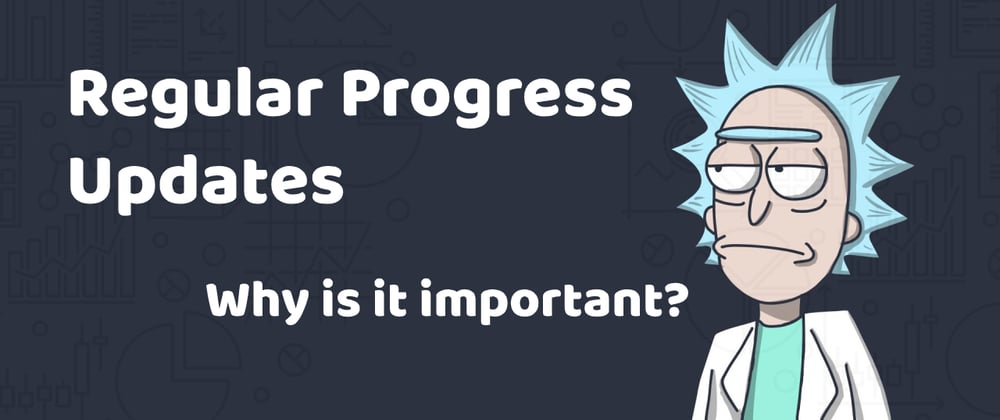Having been employed as a software engineer for seven years, I have accrued an abundance of knowledge and experiences. These have undoubtedly made a constructive impact on my career.
I have come to appreciate the importance of proactively providing progress updates to my stakeholders in a timely and consistent manner. Although this may appear to be a trivial matter, it does make a great difference between those who do and those who do not do so. I have been doing this practice since the first day on my first job and have improved it over the years.
Here are the reasons on why this is great
No questions asked
This eases the burden on the team's project manager, without imposing a sense of excessive oversight or amplifying existing pressures.
Management is crucial in establishing a clear set of expectations pertaining to the team's deliverables. As a valuable member of the team, your input will aid the management in effectively prioritizing tasks.
It is essential to bear in mind that your assigned tasks comprise your deliverables, whereas the project manager's deliverable includes the status report, which is contingent upon input from the team. Without the requisite information pertaining to the status of your tasks, the project manager's ability to accurately report on the current project status may be hindered.
They are informed and updated
While this reason is closely aligned with the first one I enumerated, I deem it necessary to highlight its distinctiveness. Specifically, this pertains to situations where a developer encounters a blocking issue, precluding the ability to progress with a task.
By promptly informing the project manager of any hindrances that impede the progress of your assigned task, you enable the opportunity to seek assistance and potentially enlist additional personnel to address the issue at hand. In addition, this would provide the project manager with the requisite insight to make appropriate adjustments, such as incorporating an "error" buffer into the deadline, should the task not be completed within the anticipated timeline.
You seem to be very busy
This practice is exclusively for your benefit, as it not only serves to provide evidence of your active engagement in a task, but also offers a sense of accomplishment at the culmination of a productive day. By effectively tracking and communicating your progress, you can readily perceive your advancements and productivity, ultimately facilitating a heightened sense of achievement.
How did it help me as a developer
My first job significantly contributed to enhance the quality and frequency of my progress updates. In order to come out on top, I had to have the actual output of my contributions and what was the impact of each contribution to the company I was working for.
As a developer, it helped me be more transparent about my daily progress and of my achievements. It shows that I have initiative and it shows my skills on how I communicate well with team. It also helps me be active and be on top of my tasks.
It's more satisfying to actually write down and see the list of what I have achieved for the day and how productive I am. It helps me evaluate myself on what I could improve and how can I be better the next day.
Where is the best place I should write my progress updates?
Ticket
I assume that your development team uses some form of ticketing tool such as JIRA. I prefer the progress updates to be written on a place where the update is related to. This way, it's organized, and there's a history of conversations and notes. When backtracking changes is needed in the future, the updates in the ticket will be a great help on why decisions and changes were made.
Development team chat
I assume that your development team uses a common chat channel where you discuss tasks outside meeting. When discussing things verbally, it is not always recorded and harder to find a proof of where a certain decision/discussion was made.
A written discussion helps answer questions in the future and most chats use search feature. This way, everyone in the team is also informed of your progress specially on situations you need to go on leave.
What I usually do, whenever we have a discussion and a decision on team chat, I screenshot that discussion and save it on the ticket related to that.
When is the best time to give my progress updates?
One update at the end of the day
For the benefit of the team - it helps them manage the tasks and priorities for the next day knowing where you at on your task. For example, if you're almost done or actually done, then they can assign you another task or if you need a hand from another person to help, they will allocate another resource to help you resolve your issue.
Update at the end of that day does not only benefit the team but also yourself. You have a sense of productivity and will help you set your goal for the next day.
Two updates - first half of the day and at the end of the day
The best example for this is when the team needs to deliver tasks the next day and giving the update on the first half of the day gives a sense of security that your team will be able to deliver the next day.
The next one is the at the end of the day where you conclude that the team actually finished the task.
These are my recommendations. However, if your team likes more updates than that, for example every 2 hours, specially if the task is high priority, then you may do so. It will always depend on the agreement/request of your team as long as it does not inconvenience you to the point that it affects your progress.
Is there a format to be followed for progress updates?
If your project manager gives you a format, then that format must be followed. Otherwise, if you are doing this out of initiative, I recommend a very simple readable format.
Sample format
[Ticket Number] Ticket Description
- List what you finished (if there is)
- List what is in progress (if there is)
- List what is pending (if there is)
- List if there are issues
- Overall status (in progress or done)
You may improve this format according to what you desire but this is what I recommend as a base format. Make sure to keep it simple, concise and direct.
Example
[JIRA-10] Create View, Add, Edit for People
- [Done] Database changes, backend code for View, Add, Edit
- [In progress] UI for View, Add, Edit
- [Pending] JQuery scripts
- [Current Issue] Having problems using a selector on DataTable. Currently researching the solution.
- [Overall status] In progress and still on time.
Take note of the current issue that I listed. It is important to let them know you are handling the situation. If you are not able to, you must mention that you might need help for example from another developer who has more experience regarding the issue.
Overall, it helps you, your team, and the company you work for.
"Businessmen are more convinced to invest if you present an actual output and statistics. Numbers and results measure accomplishment and success."
If you start doing the regular progress update as an initiative, it helps your project manager evaluate your contributions to the team and if the team is actually meeting the expected deliverable.
Let me know in the comments section your own approach or way of handling progress updates so I can improve my approach further or someone else's. You never know someone could benefit from it!








Latest comments (0)